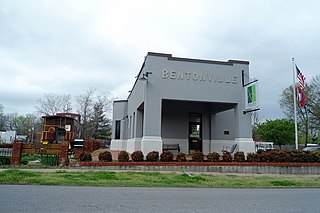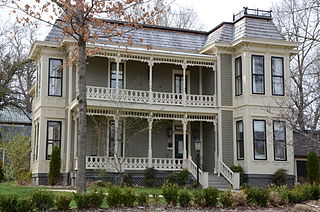
Bentonville High School (BHS) is a public high school in Bentonville, Arkansas, United States. Founded in 1910, the school provides education for students in grades nine through twelve. It is one of two high schools of the Bentonville School District.

Highway 72 is a designation for two east–west state highways in Benton County, Arkansas. A western route of 26.32 miles (42.36 km) runs east from Highway 43 at Maysville to U.S. Route 71B (US 71B) in Bentonville. A second route of 12.67 miles (20.39 km) begins at Interstate 49/US Route 71 (I-49/US 71) in Bentonville and runs northeast to US 62 near Avoca. The route is one of the original Arkansas state highways.
Elliott House or Elliot House may refer to:

The Stroud House is a historic house at SE F Street and East Central Avenue in Bentonville, Arkansas. It is a 1 1⁄2-story wood-frame structure, with asymmetrical massing and decorative shinglework typical of the Queen Anne style, and a shed-roof front porch supported by Colonial Revival columns. It is a high-quality local example of this transitional style of architecture, built in 1903 by Daniel Boone Laine and Delila Laine. The property also includes remnants of a 1925 gas station.

The Benton County Courthouse is a courthouse in Bentonville, Arkansas, United States, the county seat of Benton County, built in 1928. It was listed on the National Register of Historic Places in 1988. The courthouse was built in the Classic Revival style by Albert O. Clark and anchors the east side of the Bentonville Town Square.

Albert Oscar Clark (1858–1935), commonly known as A.O. Clark, was an American architect who worked in Arkansas in the early 1900s.

The Stroud House was a historic house at 204 Third Street in Rogers, Arkansas. It was a 1-1/2 story wood frame cottage, set across Third Street from Bentonville City Hall. It was designed by architect A. O. Clark in Colonial Revival and Stick/Eastlake architecture for a leading local merchant. It had a wide porch cross the front, supported by Tuscan columns, with a central segmented-arch section above the stairs.

The Bentonville Train Station is a former train station in Bentonville, Arkansas. Built in 1925 on Main Street, the train station served a short connector line that connected Bentonville to the St. Louis and San Francisco Railway (Frisco) to the east in Rogers, and the Kansas City, Pittsburg and Gulf Railroad to the west in Gravette. The building was listed on the National Register of Historic Places (NRHP) in 1988.

John Parks Almand was an American architect who practiced in Arkansas from 1912 to 1962. Among other works, he designed the Art Deco Hot Springs Medical Arts Building, which was the tallest building in Arkansas from 1930 to 1958. Several of his works, including the Medical Arts Building and Little Rock Central High School, are listed on the National Register of Historic Places.

Downtown Bentonville is the historic business district of Bentonville, Arkansas. The region is the location of Walmart Home Office; city and county government facilities; and most of Bentonville's tourist attractions for the city and contains many historically and architecturally significant properties. Downtown measures approximately 1.5 square miles (3.9 km2) and is defined as the region between Tiger Boulevard to the north, Highway 102 (AR 102) to the south, Walton Boulevard to the west and J Street to the east. Similar to other central business districts in the US, Downtown has recently undergone a transformation that included the construction of new condos and lofts, renovation of historic buildings, and arrival of new residents and businesses. Upon opening of Crystal Bridges Museum of American Art the increased tourist traffic related to the museum has made Downtown Bentonville one of the state's most popular tourism destinations.

The Bentonville Confederate Monument was installed in Bentonville, Arkansas, United States. It was removed in September 2020.

The Rice House is a historic house at 501 NW "A" Street in Bentonville, Arkansas. It is a 2 1⁄2-story wood-frame structure with elaborate Eastlake styling. Characteristics of the style include jigsaw-cut bracketing, spindled balustrades, and molded panels under the windows. At the time of its construction in 1890, it was considered one of Bentonville's grandest houses. The house was listed on the National Register of Historic Places in 1988.

The Benton County Jail is a historic county jail building at 212 North Main Street in Bentonville, Arkansas, United States. It is a two-story brick Classical Revival building, designed by A. O. Clark and completed in 1911. It has pronounced limestone corner quoining, and its main entrance is flanked by Ionic columns and topped by a gabled pediment. The building is notable as a rare smaller-scale work by Clark.

The Benton County National Bank is a historic bank building at 123 West Central Street in Bentonville, Arkansas. It is an elegant Classical Revival structure, designed by the regional architect Albert O. Clark and completed in 1906. It has a distinctive Roman-style temple front with three tall round-arch openings, which is sheltered by a projecting gable-pedimented Greek temple front supported by four marble columns with modified Corinthian capitals. A parapet above the Roman front obscures a dome at the center of the building.

The Bentonville West Central Avenue Historic District is a residential historic district west of the center of Bentonville, Arkansas. Located along West Central Avenue between A and G Streets stand forty houses, most of which were built between 1885 and 1935. They represent a concentration of the finest residential architecture of the period in the city. The houses are stylistically diverse, including two Italianate houses and six Craftsman houses. Notable among the former is the Craig-Bryan House, a brick structure that also has Gothic vergeboard decoration.

The Craig-Bryan House is a historic house at 307 West Central Avenue in Bentonville, Arkansas. It is an eclectic two-story brick house, with several gabled wings, and projecting bay window sections. Its front-facing gable ends are decorated with bargeboard, and there is a prominent three-story tower at the center with a shallow-pitch hip roof. Its iron balconies were salvaged from the old Benton County Courthouse when it was demolished. The house was built in 1875 by James Toliver Craig, and owned by members of the Bryan family for seven decades.

The Henry-Thompson House is a historic house at 302 SE Second Street in Bentonville, Arkansas. It is a two-story brick building, with Italianate styling that includes trusswork in the front-facing gable, a scrollwork balustrade on the main porch, and scrolled brackets on a hood over a secondary entrance. Built in 1890, this is a good representative of late Italianate style brick homes that were built in significant numbers in Bentonville between 1870 and 1895.

The Linebarger House is a historic house at 606 West Central Avenue in Bentonville, Arkansas, U.S.A. This two-story Craftsman-style house was built in 1920 by C. A. Linebarger, one of the principal developers of the Bella Vista resort area north of Bentonville. As one of the first Craftsman houses built, it played a significant role in popularizing the style in the region, with a deep porch whose roof is supported by stone porch piers, wide eaves with decorative supporting brackets, and exposed rafter tails.

The Macon-Harrison House is a historic house at 209 NE Second Street in Bentonville, Arkansas. Built in 1910, it is a large two-story brick structure with limestone trim, including corner quoining, porch columns and balustrades. This high-quality late Victorian house was built by John Macon, who profited from the local apple industry by building an applejack distillery. Macon supposedly built it as a wedding gift for his bride.

The Col. Samuel W. Peel House is a historic house museum, also known as the Peel Mansion Museum, at 400 South Walton Boulevard in Bentonville, Arkansas. It is a two-story stuccoed brick masonry structure, with a three-story hip-roofed tower at the center of its front facade. The house was built c. 1875 by Samuel W. Peel, a prominent local politician and businessman. After serving in the Confederate Army in the American Civil War, Peel studied law and practiced for many years in Bentonville. He served several terms in the United States Congress, and helped establish the First National Bank of Bentonville. Despite later alterations, the house is one of the finest Italianate mansions in the region.



















